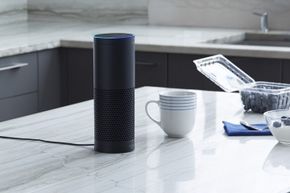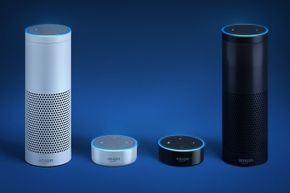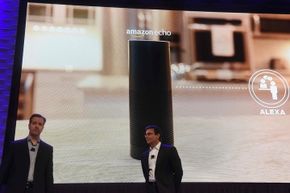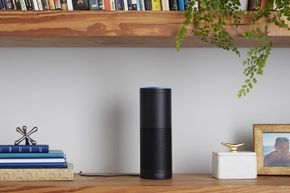Without a connection to a home WiFi network, it'll be impossible to use your Amazon Echo. The device supports dual-band 802.11 a/b/g/n WiFi network connectivity. It can't be used with ad-hoc, peer-to-peer, or enterprise networks or public networks that require extra authentication steps (like many hotel, coffee shop or airport networks).
The bulk of the work isn't taking place on the device itself. Echo sends your voice commands via your WiFi network to Alexa Voice Service to be interpreted and acted upon. Alexa is a cloud service, which means it's a software-based service running on a lot of powerful servers in one or more data centers, accessed via the Internet.
Alexa parses your spoken words, interprets the commands and routes them to the appropriate web service to get the right response. Alexa then converts the response (whether from an Alexa service or a third-party web app) and sends it back via audio to your Echo, and in many cases via text and graphical cards to the Alexa app home screen.
A social creature, Echo connects to other devices (like your smartphone) via Bluetooth. It supports audio streaming from smartphones and tablets via Advanced Audio Distribution Profile (A2DP) and voice control via Audio/Video Remote Control Profile (AVRCP).
You can manage Echo remotely with the Alexa app, which you can download to devices running Amazon Fire OS 2.0 or higher (with the exception of the second generation Kindle Fire), Android 4.0 or higher, or Apple iOS 7.0 or higher. If you don't want to use the app, you can visit Alexa's Amazon homepage.
You have to set up your Amazon Echo using either the app or the website (including connecting to your WiFi network and pairing it with the optional remote or other devices via Bluetooth). You can also use the app or site to:
- Change settings
- Consult help
- Look at and manage your shopping and to-do lists
- See and manage your timers and alarms
- Set up news and music services you want to be able to access
- See your music queue and what's playing on your device right now
In Settings, you can add an additional household member and switch the device from one user's profile to another with the voice command "switch accounts." Doing this allows you to share some digital content, but it also authorizes the other person to make purchases with the credit card on your account, unless you disable purchasing.
Alexa's voice-recognition algorithms improve with use, learning your speech patterns and word usage. The app or website's home screen will display text and graphics cards showing your recent interactions, descriptions and links to get to more related information. The descriptions show you what Alexa heard you say and give you a chance to provide feedback about whether it heard you correctly. The feedback will help teach your virtual assistant Alexa how you speak (more on that later). You can also delete the cards and the voice commands that invoked them (or delete prior commands under History in Settings), although this will apparently take away from whatever Alexa has learned about your speech.
You can further help it learn how you speak by going through the Alexa "Voice Training" session, during which you read 25 commands aloud, and by accessing your previous commands and making corrections where it misinterpreted you.
There are also third-party-created features that you can activate via voice or in the Skills section of the Alexa app or website and then use via voice command on Echo. The thousands of available skills that have come out since the Echo was introduced let you do things like order a ride from Uber or Lyft, play Jeopardy, hear tweets from your Twitter timeline, follow a seven-minute workout, get updates from your Fitbit, order a pizza from Dominos, check on your Capital One accounts and hear news from your favorite outlets. Each skill listing should show you what command or commands to use to access it.
Updates download to the device automatically. Many of its features actually reside in the cloud, where Amazon and third-party developers can add to them anytime.
Amazon's Alexa Appkit also lets third-party developers and manufacturers add Alexa Voice Service to their products at no cost. Alexa capabilities have been added to the Nucleus home intercom, the Pebble Core wearable device and Invoxia's Triby kitchen smart speaker.





